Earth sheltered home, also known as earth house, is a unique dwelling covered with or angled against the ground. They are primarily designed to be energy-efficient and they should indeed be that way. Using the earth as external thermal mass reduces heat loss and helps maintain a steady indoor temperature throughout the seasons without using additional equipment.
As architect Malcolm Wells explained earth sheltered homes; “Sunny, dry and pleasant, it offers huge fuel savings and a silent, green alternative to the asphalt society.”
Earth sheltered homes are not a new architectural concept but they are not that popular either. Slowly but surely, they are getting into mainstream architecture. Besides being energy efficient, these houses are stormproof and fire-resistant; all thanks to their earth insulated design. Additionally, they are constructed to blend into the landscape with a green roof or walls.
Types of Earth-Sheltered Homes
Earth sheltering can be an eco-friendly, passive housing alternative when combined with solar arrays. There are three types of earth-sheltered homes:
Earth Bermed House
The earth berm house is the most common type of earth-sheltered home where the walls of the building are banked against the earth. The berm may be over only one wall, polar facing, or all of the walls. There is also the option for a green roof.
Underground House
A true underground architecture piece is set in completely below the ground level, and special techniques are used for ambient light and ventilation.
In-Hill Earth Homes
Constructed into the side of a hill or slope, the in-hill earth homes usually have the front uncovered for easy access. These homes get more natural light compared to underground houses. While the sloping terrain can help with drainage, waterproofing such houses is essential. The most relatable example of this are the hobbit houses from Tolkien’s work.
Advantages and Disadvantages of Earth Homes
Every architecture type has its own benefits and drawbacks. Earth houses have the obvious advantage of being energy efficient but there are some disadvantages as well.
| Pros | Cons |
|---|---|
| 1. Energy-efficient and environmentally friendly 2. Maintains a fairly constant temperature year-long 3. Protected from elements like wind or fire and natural disasters such as storms or hurricanes 4. It requires less maintenance from the outside over time 5. Greater soundproofing 6. Lower insurance costs 7. Boasts natural aesthetic 8. Short-term rental opportunity | 1. Higher construction costs 2. Face structural problems due to moisture 3. Indoor air quality 4. Limited natural light 5. Permits and building code limitations 6. Prone to rodents and insects living in soil 7. Hard to remodel |
Frequently Asked Questions (FAQs)
Q: Is earth sheltered home cheaper to build?
A: The cost of construction of an earth house is usually more than a conventional house.
Q: How long can earth sheltered homes last?
A: An earth sheltered house can last for anywhere between 100 and 1000+ years.
Q: How earth homes conserve energy?
A: An earth sheltered home uses the ground as a natural insulator which makes it more effective at maintaining constant indoor temperature without using heating or cooling appliances.
Q: From where did earth sheltered homes come?
A: Earth sheltered houses are one of the oldest forms of building. It is believed that from about 15,000 BC migratory hunters in Europe used to insulate partially underground round huts with turf and earth.
Q: What is the history of earth houses?
A: Earth houses, or as they are known in archeology – souterrains, were stone-lined underground structures. During the Iron Age and Early Middle Ages, earth houses were used for storage, housing, and rituals. These subterranean structures are found in eastern Scotland, Ireland, Cornwall, and Brittany.
Q: What are the characteristics of earth sheltered homes?
A: The primary feature of earth sheltered homes is that they are subterranean: The entire structure built should be below grade or completely underground. Such structures also have earth-covered roofs with vegetation to reduce erosion. Additionally, they use natural insulating properties of the soil to create an energy-efficient setup. These houses are made with waterproof materials and have lower footprint.
Q: What is the difference between earth sheltered and bermed houses?
A: A bermed house may be built above grade or partially below grade, where earth is covering one or more walls. It exposes one elevation or face of the house, while covering the rest – sometimes including the roof – with earth to offer maximum insulation. Meanwhile, the earth-sheltering is an extreme version of earth berming, where only one side is left exposed and the rest is covered with soil. A bermed house is only but a type of earth-sheltering.
List of Earth Sheltered Homes from Around The World
Pick your own reason(s) and walk with us while we take you through the invigorating tour of earth sheltered homes from around the world.
Earth-Bermed House in Hudson Valley, New York

Architect: Allan Shope
Completed in 2011, this earth bermed house was built by architect Allan Shope as his own residence. There is a 12 kWh photovoltaic array for the energy requirements of the building.
The concept
It was initiated as a green architecture project. Two sides of the house are earth bermed to utilize geothermal energy. He has also used recycled materials and solar arrays to attain carbon neutrality.
Spaces
This 1,902-square-foot house features a triangular floor plan. There is a living area with a fireplace, a kitchen with dining area, and a cozy bedroom. The living spaces may seem dark but there is a south-facing glass façade to bring in plenty of sunlight.

Earth Sheltered House in Rocky Mountains, Colorado

Architect: Gluck+
This 2,850-square-foot house in the Rocky Mountains was designed by Gluck+ in 2004. It was later updated with new structural additions that didn’t obstruct the view.
The concept
It is designed as a guest house that blends into and accentuates its mountain landscape. The house utilizes the earth’s thermal mass for maintaining the temperature inside the house.
Spaces
The architects have built the guest house as two rectilinear steel-framed bars that intersect to create a courtyard. The primary bar contains open living and dining spaces, while there are three bedrooms and a garage on the other axis.
There is a private sunken courtyard for the family to gather and sit together. The continuous clerestory glass windows on the façade bring in panoramic views and create day-lit space. Solar arrays are also used in this earth berm house.

NCAVED House in Serifos Island, Greece

Architect: MOLD Architects
Completed in 2020, this one-of-a-kind house is located on a small secluded rocky cove on Serifos Island, Greece. The walls of dry stone outline and protect the interior and exterior spaces.
The concept
The project aimed at creating a protected shelter that can withstand strong north winds and also blend into the landscape. The architecture firm has built the NCAVED house in a rectangular grid to the slope that accommodates and isolates the residence quarters at the same time.
Spaces
The unique residence is divided into three levels: bedrooms, living rooms, and a guest house. The front is fully open to the east view, while the rear windows open to indoor gardens, enhancing the airflow and bringing in natural light into the residence.
Lighting and ventilation with front and rear openings, stone walls, a planted flat roof, and energy-efficient glass panels are some bioclimatic features of the house.

Also Read: 20 Awesome Houses in the Forest You’ll Want to Own
The Horizon House in San Bernardino, Paraguay

Architect: Bauen
This 345-square-meter house was completed by the architecture firm Bauen in 2019. It is partially buried under the ground to match the downhill topography of the site.
The concept
With the intention to minimize the impact on the site, this house is cantilevered over the ground.
Spaces
There are two horizontal parallel plates of concrete, joined together by four columns on one level that create a strict grid of nine modules to serve as different living spaces. This architecture is wrapped in vertical planes that can be closed for privacy and opened to bring the outdoors in.
The earth house is topped off with a lush green cover that besides reinforcing the thermal insulation integrates the space with the surroundings.

Pachacamac House in Lima, Peru
Architect: Longhi Architects
Completed in 2008 by Longhi Architects, Lima, for a couple of retired philosophers, Pachacamac earth sheltered home is spread across 480 square meter area near pre-Inca remains, 60 miles south of Lima, Peru.
The concept
The idea was to bury the house inside the hill in order to create a balance between architecture and landscape, where inside/outside becomes a constant interpretation of materiality with a strong sense of protection and appreciation of the dark and the light.
Spaces
Perfectly blending into the environment, this partially underground house is masked inside a hill with two levels buried in the ground. A glass box that protrudes out of the hill symbolizes architectural intercession on virgin territory. The house plays with the indoor and outdoor spaces in the shape of volumes and airy rooms with holes drilled in the walls.
Not to forget, the hardships that architects had to go through. Some of them being no electricity or sewage water systems, which meant alternative energy solutions had to be found for the house. This naturally led to a closer human-environment relationship, which eventually became one of the main features of the Pachacamac earth sheltered home.

Sedum House in Gimingham, North Norfolk, UK
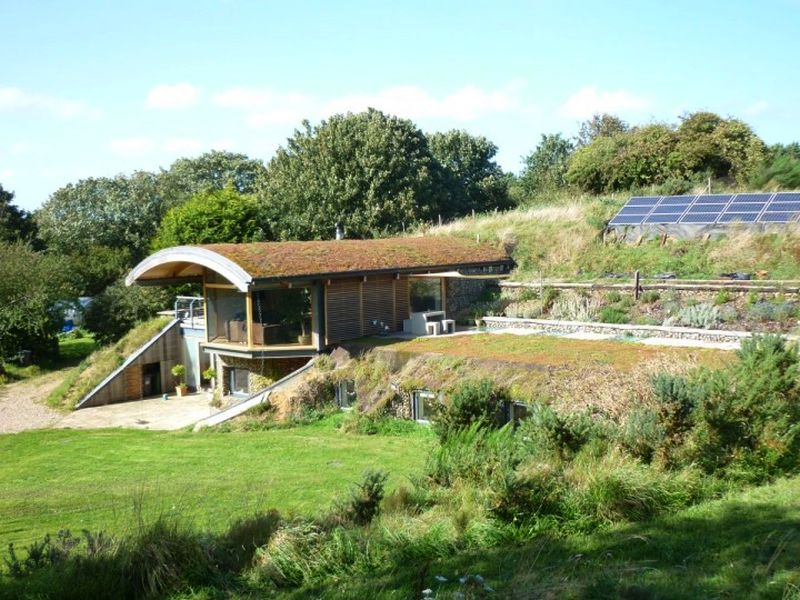
Architect: CAM Architects
Completed in 2007, this award-winning earth sheltered home by CAM Architects is located in Gimingham, North Norfolk. It is home to one of the directors of the firm who is still basking in the eco-friendly and low energy requirements of this house.
The concept
This private residential house is the perfect example of what our future homes should be like. With sustainability at the core of its design, this earth sheltered home has green technology incorporated wherever possible. There are ground source heat pumps, photovoltaic panels on the roof and smart ventilation system giving it eco-friendly credentials. For insulation, there are ICF walls that keep the indoor temperature constant all year round.
Spaces
This sustainable home is spread across an expansive land area, giving it a very open feel. The earth sheltered house has big rooms and sections that make it feel like any other spacious home.
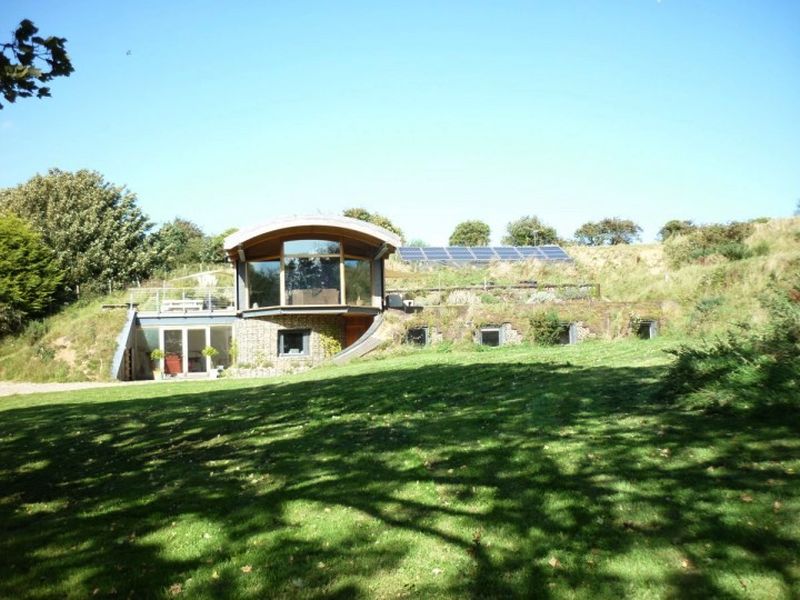
Hebridean Earth House in Askernish, South Uist, Scotland
Architect: Hebhide
This earth sheltered house in Askernish on South Uist Island, Outer Hebrides, Scotland is a dream vacation spot set in a beautiful landscape. The name of this holiday rental is aptly dubbed “Hebridean Earth House” owing to its location and the manner in which it is built. The house is more like a modern version of a Stone Age building with traditional features like a ledge and braced doors.
The concept
This dwelling is built for living away from the busy city life and soak in nature, as you enjoy the majestic view from the window. Or perhaps, you would like to relax while sipping a cup of piping hot coffee, feeling the cool breeze coming from the stream running adjacent to the house.
Spaces
Hebridean Earth House is a luxury home with an underfloor heating system. There is a spacious living area that has a plasma fire exuding a warm appeal. Other than that, there are entertainment systems to keep you engaged during your stay.
The home has a fully-equipped kitchen, a tech-savvy bedroom, and a dining room with a chaise lounge for relaxation. The bathroom is also draped in luxury to complement other sections of this house.

Aloni in Antiparos Island, Greece

Architect: DECA Architecture
Completed in 2008 by DECA Architecture for Oliaros AE (Antiparos Design Projects), the Aloni earth sheltered home is spread across 237 square meters in Antiparos, Greece. The name “Aloni” refers to the remains of a crop-harvesting circle that was found and preserved as part of the agricultural past of the site.
The concept
The basic structure of the earth house is inspired and influenced by the location’s topography and local domestication techniques which are an integral part of the traditional Cycladic architecture.
Instead of designing the house, DECA redesigned the landscape so that it could be inhabited. The main tool in this process was the transfer of earth and the formation of a new topography that incorporates the volumes of the residential area while protecting it from the wind.
Spaces
The site is a natural saddle where two slopes meet. Two long stone walls bridge the hills, allowing the house to nestle between the space while maintaining the continuity of the landscape flowing over it. The single-level 237-square-meter villa has four internal courtyards drawing light and breeze inside the expansive living room, four bedrooms, a playroom, and study.
On the sea-facing side, a pool terrace promises unforgettable moments while watching the sun set in the distance. It is here where the villa’s architectural concept truly and gloriously comes to life, as you literally lay inside the mountain’s embrace.
Recognized honors
The house has received The Architectural Review, AR House Awards in 2010. It also bagged the Piranesi Award 2009, Piran Days of Architecture and was a finalist entry for the Greek Architectural Awards 2009, Hellenic Institute of Architecture.

Robot Ranch in Ferris, Texas
Architect: Al Schwarz
Designed by Al Schwarz, Robot Ranch is a monolithic dome home located in Ferris, Ellis County rural town, Texas. The earth sheltered home is completely covered in rock, making it unique in its own right. With inspiration derived from his love for monolithic dome homes, Al started construction of this home with slate and travertine tile, with storage shelves of concrete blocks. This enables it to blend perfectly with the surrounding landscape, giving it the appeal of a stone house.
The concept
Al’s earth sheltered home has a multi-level retaining rock wall that encapsulates the whole structure. This also creates a base for garden plants and natural greenery to flourish. The home itself is an interconnected network of domes covered in rock that double as a stone pathway to move around.
Spaces
The home is filled with natural light and greenery all around. There’s every accessory that one can ask for in a luxurious home, making it ideal for a getaway. There’s a self-ventilating system to maintain temperatures and solar power which gives it eco-friendly touch. Also, judicious use of wind energy is done to save power which keeps the energy bills down.

Edgeland Earth-Sheltered Home in Austin, Texas
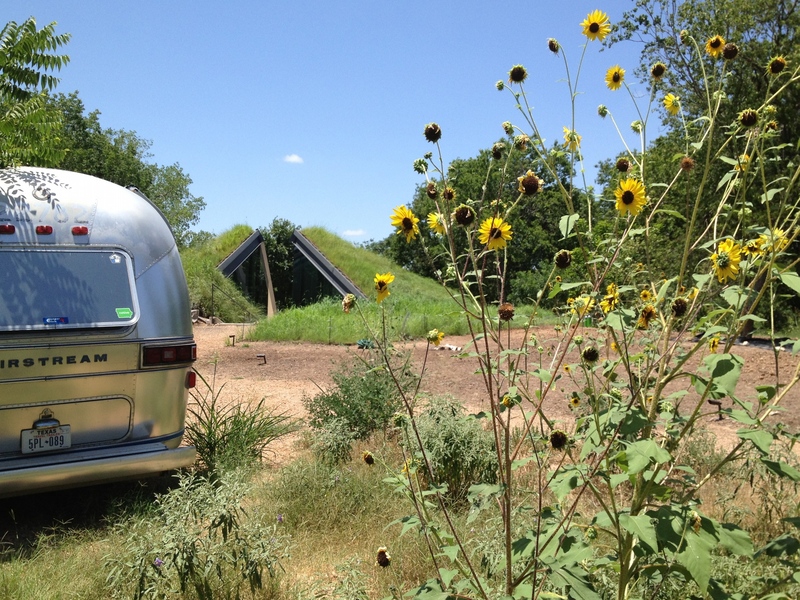
Architect: Bercy Chen Studio
Completed in 2012 by Bercy Chen Studio, from Austin, Texas, for Chris Brown, (a lawyer by day, science-fiction writer by night) Edgeland House or Chris Brown’s ‘Nature Bunker’ (as he likes to call it), the house is spread across a 1,400-square-foot area adjacent to the Colorado River.
The green roof architecture is the work of John Hart Asher of the Ecosystem Design Group at the Lady Bird Johnson Wildflower Center in Austin. He planted more than 40 native species of plants and wildflowers on the roof and site, which helps protect the local ecosystem immensely.
The concept
The home became a modern reinterpretation of the old architecture in North America, the native American’s “pit house,” which is typically sunken, taking advantage of the earth’s mass to maintain thermal comfort throughout the year.
The inspiration came from the site which was originally a rehabilitated brownfield (formerly industrial) site. Edgeland Residence is about healing the land and ameliorating the scars of the site’s industrial past.
Spaces
This earth home is broken into two separate pavilions or wings (West and East). The west wing contains the living and dining rooms, as well as the kitchen while the east wing has two bedrooms, two bathrooms, and a writer’s attic/den across the courtyard. The living area with floor-to-ceiling windows opens up to a large deck area and a pool.
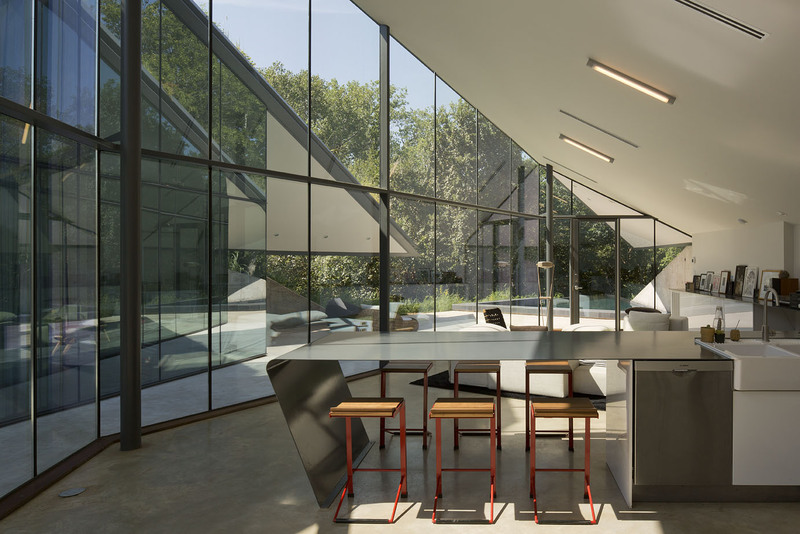
The courtyard is a theater for observing migrating hummingbirds, monarchs, butterflies, and even ant colonies; heightening one’s awareness of nature in an urban setting. The system combines hydronic heating & cooling, geothermal heat exchange, phase change thermal heat storage, and a green roof for maximum energy efficiency.
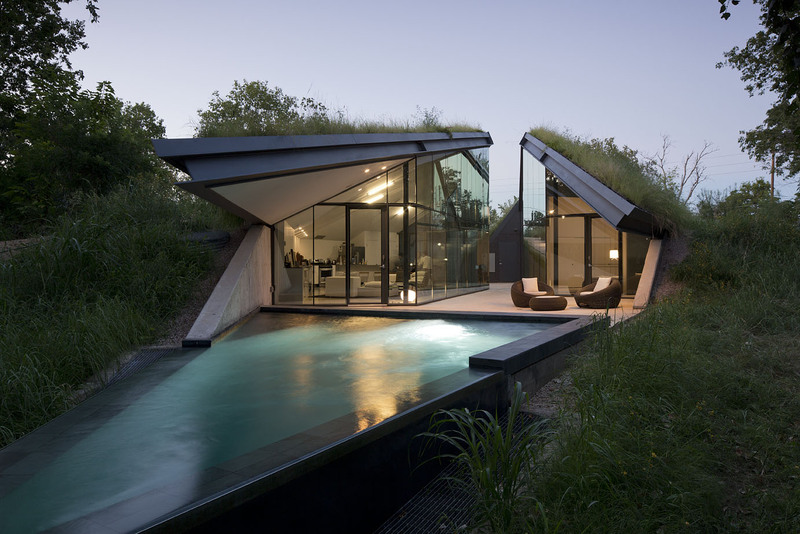
Ktima Villa in Greece

Architect: Camilo Rebelo + Susana Martins
Completed in 2014 by Camilo Rebelo and Susana Martins, from Antiparos, Greece for Oliaros SA – Iasson Tsakonas, Ktima Villa is spread across 950-square meters. Ktima, in Greek, means farm or parcel with fertile land.
The concept
Order and chaos can be found in Greek civilization throughout the ages, including today. Both of these were part of the concept for this earth sheltered house. The main idea of the project was based on two elements: the existing walls at different levels and the platforms created by those walls.
The elevations of these two levels of the earth house are two broken lines that were created as a continuation of the existing walls. The topography helps dissimulate the house on the site. The distance between the two façade lines designs a platform where the exterior living spaces can happen.
Spaces
The structure is divided into two levels: the entrance level being the main house and the lower level housing the guesthouse, service and staff areas. The interior arrangement of the premises is bright, welcoming, and flamboyant. It successfully combines contemporary art and furnishings with rustic elements, and typical local textures.
The sunlight and bright reflections create an ambient indoor environment which is further enhanced by the Mediterranean-style interior design dominated by white, gray, and blue. Palazuelo’s paintings are also one of the most relevant references for this house.
This house has a green roof which helps maintain constant temperatures indoors without the need for any active cooling systems.
Recognized honors
One of the most exclusive and unique properties on Antiparos, Ktima is a contemporary holiday house that has been featured on BBC’s The World’s Most Extraordinary Homes. Located on a perfectly quiet and private part of the island, Ktima Villa is part of the award-winning Antiparos Project by Oliaros, too.

Villa Vals in Vals, Switzerland
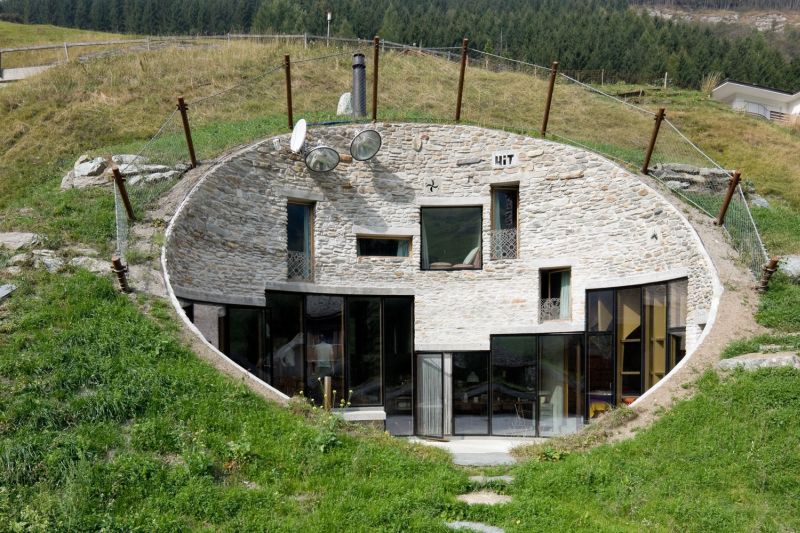
Architects: SeARCH, CMA
Completed in 2009 and designated by Bjarne Mastenbroek & Christian Müller, Villa Vals is spread across 225 square meters in Vals, Switzerland.
The concept
Surprised that it was permissible to construct a pair of dwellings so close to the world-famous thermal baths of Vals, the client seized the opportunity to develop the site, without disturbing the bath’s expansive views. There is a central patio in the steep incline area which creates a large façade optimal for window openings.
The viewing angle from the Villa Vals is slightly inclined, giving an even more dramatic view of the strikingly beautiful mountains on the opposite side of the narrow valley.
Spaces
This extensively designed two-level earth sheltered house is set amidst a beautiful landscape with fortifications on all sides. Inside, it is a luxurious mansion with a full-blown kitchen, a living room with a modern design, and a bedroom that bears a unique theme. Overall, this green roof home is perfect for staying in harmony with nature.
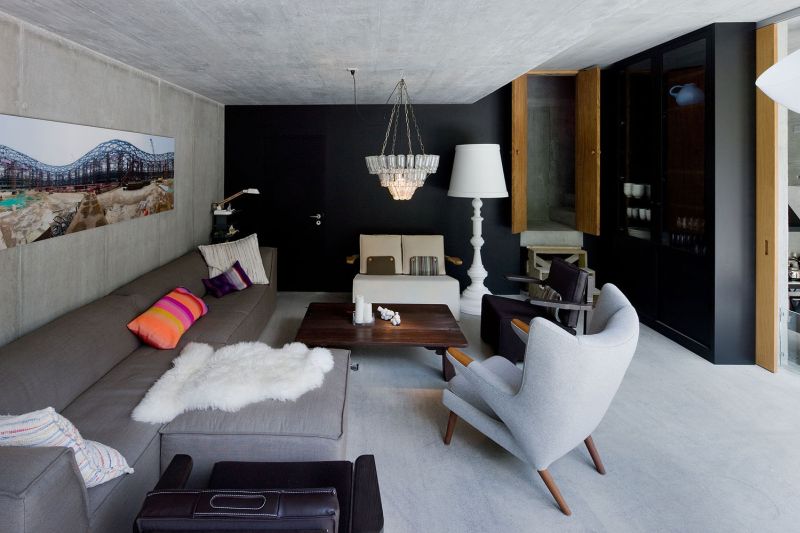
OUTrial House in Ksiazenice, Poland
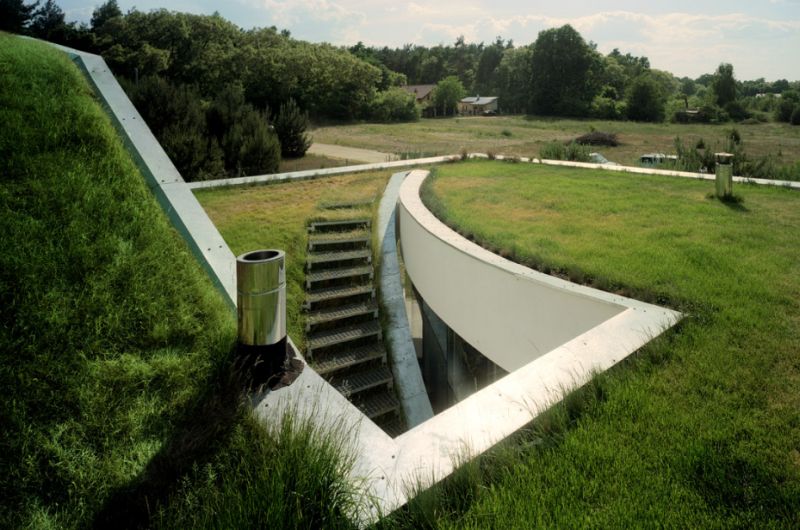
Architects: KWK Promes
Completed in 2007 by KWK Promes for a rock musician, the OUTrial House is spread across 1,440 square feet in Ksiazenice, Poland. The most interesting feature of this unique design is that the landscaped roof is only accessible from inside the house.
The concept
The dwelling has an underground atrium made by creating an opening into the sky. A typical atrium; the newly-created space has all the advantages of an outer garden while remaining a safe, internal zone within the building.
A new type of earth sheltered home was created, and its designation “OUTrial” is to convey the idea of an atypical atrium which is part of both the interior and exterior.
Spaces
Underneath the camouflaged façade, this secluded den hides away all the modern-day amenities for a comfortable stay including living rooms, functional spaces, and even a sound studio.
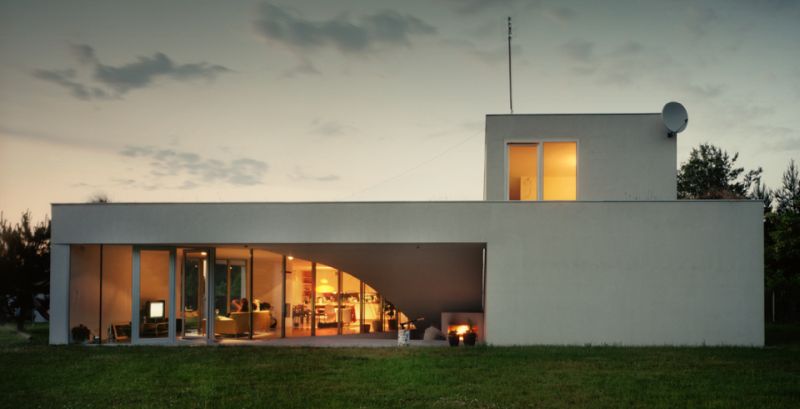
Hobbit House in Quindalup, Busselton

Architect: Nigel Kirkwood
The work of Nigel Kirkwood from Australia’s southwest region, this earth sheltered home sits pretty in Quindalup, around 20 km from Busselton. Kirkwood has spent 25 years in the WA mining industry, which inspired him to create this hobbit home-style dwelling.
The concept
Nigel’s earth sheltered home is made from almost 1,000 tons of earth material covering it partially. This gives the home a consistent indoor temperature all year round, cutting down on energy bills. During blossom time, the roof is covered with flowers, bringing a variety of birds and insects to the location.
The fact that it is amidst nature gives this green roof architecture an aesthetic appeal. The landscaping done in and around the house also makes it worth drooling over.
Spaces
This earth sheltered home has large windows which permit ample daylight making it very bright and airy inside as compared to other similar structures. The single-level home has structural strength thanks to 19 tons of high-quality steel used. The steel is draped in Polyurea waterproof coating which makes it completely fire-proof. Intelligent use of insulation gives it all-proofing properties, making it soundproof from outside noises.
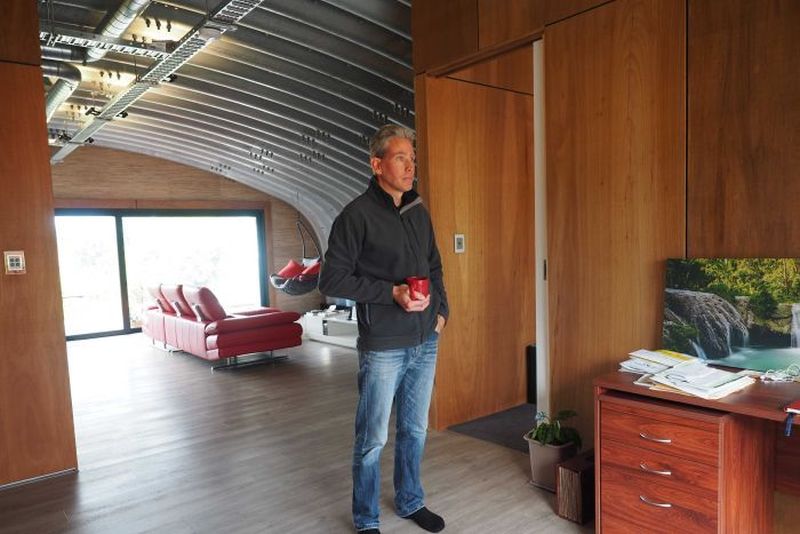
The House Underground in Eindhoven, Netherlands

Architect: WillemsenU
This serene earth-sheltered house is designed by architects at WillemsenU in a remote countryside. It is built into the lush landscape so seamlessly that it is rarely visible at the first glance. The House Underground has a contoured shape, offering an organic hill shape to the live roof with wildflowers and buzzing bees.
The concept
WillemsenU’s earth home is located on the periphery of a protected nature reserve in Eindhoven. It was designed to cater to the clients’ wish to find a peaceful haven in their busy lives, where they could enjoy some unplugged time surrounded by natural beauty, privacy, and tranquility.
Spaces
Despite its subterranean design, the house gets plenty of natural light thanks to a glass platform lift and open-plan floors, while keeping an outdoor-indoor connection intact. The natural insulation from the earth ensures energy efficiency. It was made using wood and in-situ concrete with a wooden slat texture to pay tribute to the site’s original goat shed. It includes a kitchen-diner space, indoor terrace, a living room, and two bedrooms.

Things to Consider When Building Earth-Sheltered Homes
Earth-sheltered homes are sustainable and eco-friendly. These naturally energy-efficient dwellings can be rewarding and great residential solutions. If you too want to build and live in such a dwelling, here are seven crucial things to consider before you start on an earth-sheltered house project.
Lifestyle and Family Needs
Earth-sheltered homes, while beneficial, may not be everyone’s cup of tea. These structures can be adaptable, but you need to consider your lifestyle and the family’s needs before you begin down this path. If you have children, they may not like living in a subterranean house, which could be a cause of friction. Since, earth-sheltered homes receive limited natural light, they seem dark and dingy, which is a turn-off for many people. Therefore, you need to evaluate these aspects and decide if this is the right choice for you.
Location
The location of your earth home matters significantly. It is vital to understand the climate of the site that you are choosing to build the earth-sheltered home, along with the geology, topography, and hydrology. Analyzing these factors will help determine the stability of your house and ensure that it is not prone to land sliding or flooding. Finding the right location will provide you with durable and sustainable housing.
Building Codes and Permits
Before you dive into any sort of construction projects, not just earth-sheltered homes, it is imperative to know the building codes and permits in your area. This way, you sidestep a major roadblock and work within the government requirement and regulations, which will save you time and money in the future, and possibly, the headache of demolition. Checking with your local authorities to see if earth-sheltered homes are allowed in your region is a wise decision, which you should not skip and be thorough about.
Designing and Building
Once you have the permits and design codes from the local government and have finalized the location, it is time to design and build. The design of earthen homes is understandably far different than other house styles. The traditional structures mostly rely on artificial ventilation systems to keep the indoor temperatures optimal, whereas the earth-sheltered homes make the most of natural insulation and ventilation. However, this aspect very much relies on the design and architecture of the structure. You need to consider insulation, waterproofing, and ventilation to create an abode that is comfortable, safe, and clean.
Materials
The type of material you use for your earthen home determines the longevity and viability of the structure. Since it is going to be built into the earth, it needs specific materials to prevent water damage, erosion, and other issues. For example, the exterior walls need to be made from materials that can resist moisture and pressure. Compressed earth blocks can prove to be a good pick for this.
Costs
The cost of your earthen home can be more expensive in the beginning due to the requirement of specialized materials, permits, and building techniques. But if you think about the long-term costs, these structures can offset the high upfront expenses with long-term savings in energy costs as they provide natural insulation properties. You can also lower the material expenses with inexpensive materials such as cob and adobe.
Construction Expertise
Once you have everything considered and analyzed down to the dot, you need to hire a construction expert. Earth-sheltered homes are very different from the typical traditional homes. Therefore, these need a builder who has expertise in this type of construction, because not everyone understands the ins and outs of these buildings and you need to find a professional with substantial experience in these building types to prevent any hazards and cost spikes.
Follow Homecrux on Google News!




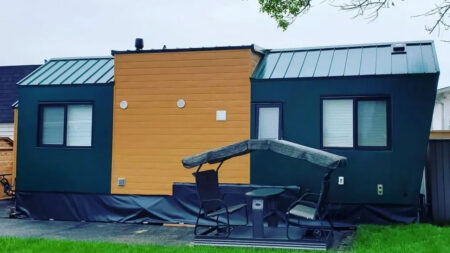
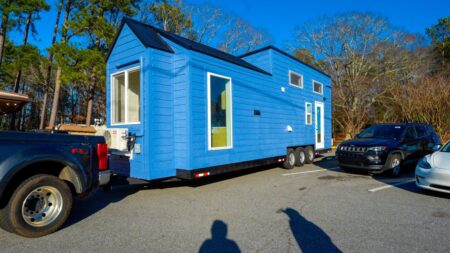
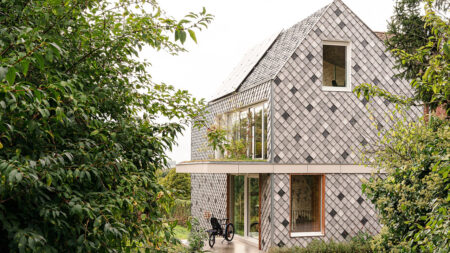
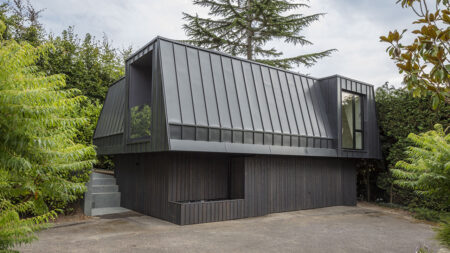
Very nice earthen homes. We need this concept especially with fire danger due to climate change.
True Irene, couldn’t agree more!
These are absolutely incredible. Is it possible to build on a smaller scale? Are there images of 3 bedroom, 2.5 bath living room, family room full kitchen, laundry and perhaps a sauna?
Yes could be absolutely feasible!